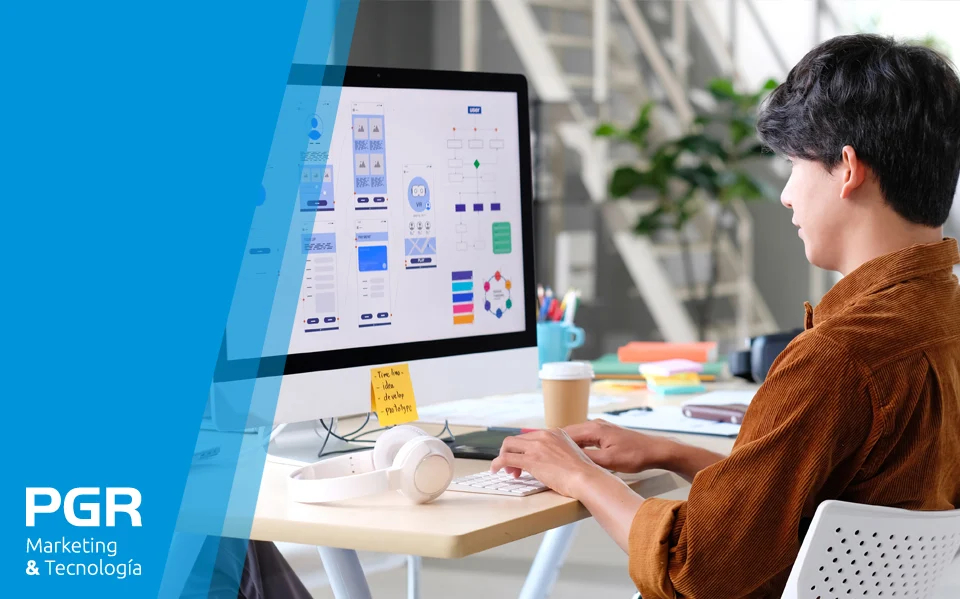We can often find the expressions UX (User Experience) and UI (User Interface) in the same sentence, but this does not mean that they are interchangeable concepts. While one refers to the user experience and feel, the other is directed towards a more rational side of navigation.
Although UX and UI are different practices, they overlap and complement each other in ways that it can be confusing to understand what makes them different and how they work together to create a successful page.
UX and UI are two disciplines that work hand in hand to create a product, service or website that is enjoyable and intuitive for customers to use . User interface (UI) is concerned with the aesthetic properties of a digital product, such as the look, feel, and layout of all the elements a user can interact with. Meanwhile, the user experience (UX) is more general and conceptual. UX considers a user's journey through interacting with your product, how it solves their problem, and how it makes them feel. UX without UI is like the engine of a car, but without the wheels or the body. You need both to get where you want to be.
What is UX?
UX design is the process of connecting the interaction between human users and products, services or websites. To create an optimal user experience, a UX designer will do research, conduct surveys, and tests to fully empathize with users and address their needs.
What is UI?
A UI designer is responsible for the appearance of the product's interface. This includes colors, fonts, spacing, and anything else you can see and interact with in an interface. The UI picks up where the user experience ends by transforming your research and insight into customer needs into a functional and engaging interface.
Let's see the example of YouTube to better understand the meaning of both concepts: If we look at the YouTube home page, we will realize that all the visual elements of the page are the work of a UI designer: the search bar, the choice of the type of font and colors, the space between videos, the presence of the brand, the subscription bar on the left and everything you can see and interact with on the page. However, when we look at the information that is shown to us first and how the product works when we interact with it, we are entering the realm of UX.
The person in charge of the UX design is responsible for aspects such as the loading speed of the videos, the correct functioning of the search algorithm, etc. In short, the UX design is responsible for ensuring that you enjoy a good experience while using the page.
Donald Arthur Norman, the American scientist in the field of cognitive science who coined the term UX in the 1990s, and his partner Jakob Nielsen tell us the difference between UX and UI as follows:
“Imagine a website with movie reviews. Even if the user interface for finding a movie is perfect, the user experience will be poor for those wanting information on a humble independent release if the underlying database only contains movies from major studios.”
In his example (and in all good products), UX and UI come together to create a totally enjoyable experience. Even the most beautiful user interface imaginable cannot be appreciated if the product does not work the way the user intended.
While user interface (UI) is visual, user experience (UX) is conceptual and focuses on developing and improving a user's path to solving a problem.
In short, a UX designer must answer the question: “How can my company's product best meet the needs of our users?”
On the other hand, if you've ever visited a website and thought, “Wow, this company is great and has a great product, but it was the intuitive and elegant design of their website that sold me” that's largely because of your UI designer.
Now that we know what UX and UI are separately, let's see how both concepts respond by working collaboratively: Suppose your company wants to develop an application and hires a UX designer. The UX designer will first conduct research on competing apps and their user pain points.
Using this information, you'll decide on the main features of the app (“must track heart rate and mileage”) and research users in depth to create a sitemap and initial prototype.
From there, a UX designer will create wireframes, which they will test, refine, and turn into mockups. Throughout all stages, the UX designer focuses on the structure and value of the product and how that product does or does not meet the needs of the user.
Towards the end of development, a UI designer will take control of the app's appearance, including forms, images, buttons, links, and on-screen icons.
The main difference between UX and UI is their goals: a UX designer focuses on the entire journey of users using a product to solve their problem or satisfy their needs.
A UI designer is told what the app should include and exclude, and how it's going to work. With this, he designs an interface that is intuitive to use and materializes all the needs of the users on the screen.
To create a product, solution, or website, you require UX and UI. Without a UX designer, YouTube would be a pretty page, but completely unusable. And without a UI designer it would be a great idea in theory, but it would be difficult and confusing to navigate the screen.
At PGR, we offer the Graphic Design and Web Programming service, especially focused on B2B companies in the ICT Sector.





